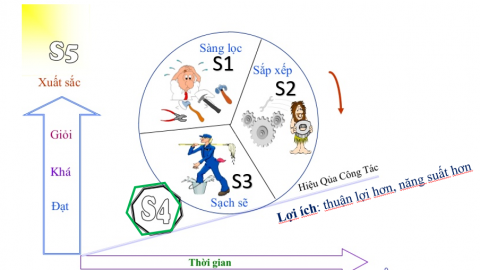
Maintain the continuous implementation of 5S
5S is the name of the five actions, starting with the S in Japanese, including Seiri (screening), Seiton (sorting), Seiso (clean), Seiketsu (caring) and Shitsuke (ready), introduced by Mr. Takashi Osada in 1980 and widely popularized by the international community in industrial production activities.
Seiri includes activities of selecting and screening items into two groups that are necessary and unnecessary (Cura 2003, Michalska & Szewieczek 2007) and are the first step in implementing 5S. Seiton involves establishing routines that arrange the necessary applications to be easily accessible (Cura 2003, Ho 1999, Mateus 2011). Seiso focuses on maintaining a clean workplace by offering regular workplace cleanup activities (Michalska & Szewieczek 2007, Osada 1991, Mateus 2011). Seiketsu means that everything needs to be easily identifiable (Becker 2001) with easy-to-see labels for all production operators (Riera 2010). Shitsuke includes the activities that maintain each action in the 5S stated (Sacristan 2005). 5S can be understood as a simple internal management method to organize work areas focusing on conspicuous, easy-to-take, clean and standardized goals.
The scope of 5S application in some countries is not entirely the same. Japan emphasizes that 5S is a strategy to achieve business perfection and requires implementation in both workplaces and families, while 5S in the UK and the US is only considered a system or a tools at work. In some countries, the application of 5S is only considered as a simple method to meet the minimum health and safety requirements in the workplace (Jimenez et al., 2015).
The great success and development of Japanese industry in the period 1960-1990 has a remarkable contribution of 5S in improving productivity, quality and creating a safe working environment. Today, 5S is not only applied in industrial production activities but also expanded to other areas such as offices, services, commerce, etc and gradually becomes a part of Japanese people’s culture. Copy. While some Japanese enterprises are looking to upgrade 5S to 6S, which adds Safety (safety) activities, some other Japanese businesses shorten 5S to 3S (the first 3 actions are stated above).
Similar to the general situation in the world, the introduction and implementation of 5S in Vietnam has been implemented in some businesses, but the model replication and long-term maintenance are limited due to the lack of information sharing. about the point model and the practical instruction manuals.
Decision 604 / QD-TTg approving the project “Improving productivity and product quality of industrial goods” under the national target program “Improving productivity and quality of commodity products of enterprises. Vietnam to 2020 “targets 100% of enterprises producing key industrial goods to build and implement projects to improve quality productivity in the period 2016-2020.

Studying the success of implementing 5S application in 36 enterprises supported by the Ministry of Industry and Trade in the 2017-2018 period, according to Decision 604 / QD-TTg, shows that 100% (36/36 companies) are can carry out activities S1, S2, S3 right after 5S training (employees of the company come up with their own initiative and implementation); 20% of companies launched their own solutions for S4 and S5. The results of 5S implementation at these 36 enterprises also indicate a number of important activities, ensuring the maintenance of 5S regularly and continuously:
+ 5S training for employees is an activity that needs to be done early (S1, S2, S3 training for company employees, and S4, S4 training for managers from the group leader and up)
+ Visual changes (even the smallest), improvements in placement, open and clean workplaces should be recorded and shared via message boards, groups (zalo, viber).
+ Internal 5S scoring activities should apply to medium and large scale companies (with many departments and divisions). For small-scale companies, it is possible to replace 5S scores with monthly summarizing activities achieved by S1, S2 and S3.
+ In order to maintain 5S, it is important that the company periodically has at least one of the following activities: (1) acknowledging, (2) commending, (3) checking, (4) evaluating, (5) awarding / awarding the achievements of S1, S2 and S3 of each individual / workshop.

In addition, the support of the company leadership for 5S will contribute to ensure 5S is maintained regularly and continuously at the company.
Productivity and Quality Office